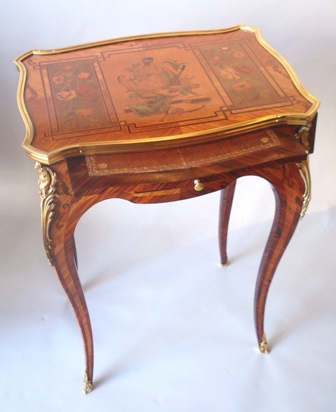|
|
BEURDELEY

BEURDELEY dynasty
One of the most important dynasty of cabinet maker from the second half of the nineteenth century.
The Beurdeley family were a flourishing dynasty of three generations of fine quality cabinet-makers, working to an exceptional standard and wide virtuosity, from 1818 to 1895. The firm was particularly well known for its exceptional metalwork, most commonly copying important Eighteenth Century examples. The ormolu mounts on Beurdeley furniture and the numerous smaller artifacts, often marble pieces, are almost invariably of an exceptional high quality. The mercurial gilding and hand chasing are of a standard that makes them difficult to distinguish from late Eighteenth Century work.
BEURDELEY Jean (1772-1853)
The founder, Jean Beurdeley, built up a modest business and reputation, the fruits of which were later to be reaped by his son and grandson. Established in Paris by 1804 at 355 rue Saint-Honore (1818) and 364 rue Saint Honore (1820-1839). In 1839 he purchased the famous Hanover Pavilion situated on the corner of rue Louis-Legrand and Boulevard des Italiens, this can be seen as evidence of his success at this time.
Louis-Auguste-Alfred BEURDELEY (1808-1882)
He took over the business at Hanover Pavilion where he greatly built up his father's practice. He specialized in the manufacture of furniture inspired by the eighteenth and particularly Louis XVI. He quickly became the most famous cabinetmaker of Paris. The Duke of Nemours, Napoleon III and Empress Eugenie were his clients. He exhibited at the Universal Exhibition in 1855 and in 1867.
Alfred-Emmanuel-Louis BEURDELEY (1847-1919)
He worked at first with his father, Louis, and eventually succeeded him in 1875. Alfred kept the shop at Hanover Pavilion and also had workshops at Nos. 20 & 24 Rue Dautancourt. The business continued in its traditional style with very few variations, until 1895. Alfred, along with Dasson, Grohe, Sauveresy and Fourdinois, the most famous artists of the period, took part in the 1878 Universal Exhibition, where he won the gold medal. Following on from this glory he went on to open a shop in New York. His participation in the 1883 Amsterdam Universal Exhibition drew even further attention to his work, and possibly as a result he was awarded the Ordre National de la Legion d'Honneur, France's highest official mark of recognition. A stamp of both government and contemporary art critics approval.
When he closed its shop, Le fond d'atelier was so rich that it took five sales to liquidate more than two thousand pieces.
|



